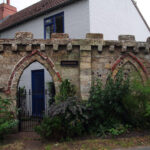3 November 1694: Leeds’s borough treasurer is mandated to pay goldsmith Arthur Monjoy £61 for making the ceremonial mace
James Wardell. 1846. The Municipal History of the Borough of Leeds, in the County of York. Leeds: Longman, Brown, and Company. Get it:
.Excerpt
The first notice of the Mace now used by the Mayor of this Borough, for the time being, occurs in an Order of Court dated the 3rd of November, 1694, whereby the Treasurer is ordered to pay unto “Mr. Arthur Monjoy, Goldsmith,” the sum of £60. 11s. 0d. [£10K in May 2023] for making the same. This insignia of office is of silver gilt, and measures 4 feet and 8 inches in length, and the shaft thereof is beautifully engraved and ornamented. The head is encircled by a border of foliage, measures 18½ inches in circumference, and is divided into four compartments by antique figures, containing the national insignia of England, France, Scotland, and Ireland, surmounted by the respective royal crowns of these kingdoms. The whole is surrounded by the imperial crown of Great Britain, with a double row of fleurs-de-lis and crosses pattée. Beneath the bows of the crown are the royal arms; namely, Quarterly, 1st and 4th, France, and England quarterly; 2nd, Scotland; and 3rd, Ireland. The initials of the sovereigns, namely, W. and M.; crossing each other, with the letters R. R., (standing for Rex and Regina,) occur four times on the upper part of the head of the Mace, the entire weight of which is about 123 ounces. On the upper side of the base is inscribed “Arthur Mangey de Leeds. Fecit. 1694,” and on the lower “MARMEDVKE HICK, 2 MAIOR. THO: DIKSON,” with the old arms of the Borough, surmounted by the motto “BVRGVS DE LEEDS.” It has been generally supposed that Mr. Monjoy, or Mangey, gratuitously presented the Corporation with this Mace, but the Order of Court of the last mentioned date, sufficiently proves the contrary.
Comment
Comment
I suspect Wardell’s real pleasure is in his footnote:
This person was found guilty and executed at York in 1696, for counterfeiting the current coin. The attic story of his dwelling-house in Briggate, was the place he used for this purpose, and was discovered in 1836, by some workmen engaged in repairing the premises. The apparatus used by him, together with a few silver coins were also found at the same time therein.
Something to say? Get in touch
Original
The first notice of the Mace now used by the Mayor of this Borough, for the time being, occurs in an Order of Court dated the 3rd of November, 1694, whereby the Treasurer is ordered to pay unto “Mr. Arthur Monjoy, Goldsmith,” the sum of £60. 11s. 0d. for making the same. This insignia of office is of silver gilt, and measures 4 feet and 8 inches in length, and the shaft thereof is beautifully engraved and ornamented. The head is encircled by a border of foliage, measures 18½ inches in circumference, and is divided into four compartments by antique figures, containing the national insignia of England, France, Scotland, and Ireland, surmounted by the respective royal crowns of these kingdoms. The whole is surrounded by the imperial crown of Great Britain, with a double row of fleurs-de-lis and crosses patteè. Beneath the bows of the crown are the royal arms; namely, Quarterly, 1st and 4th, France, and England quarterly; 2nd, Scotland; and 3rd, Ireland. The initials of the sovereigns, namely, W. and M.; crossing each other, with the letters R. R., (standing for Rex and Regina,) occur four times on the upper part of the head of the Mace, the entire weight of which is about 123 ounces. On the upper side of the base is inscribed “Arthur Mangey de Leeds. Fecit. 1694,” and on the lower “MARMEDVKE HICK, 2 MAIOR. THO: DIKSON,” with the old arms of the Borough, surmounted by the motto “BVRGVS DE LEEDS.” It has been generally supposed that Mr. Monjoy, or Mangey, gratuitously presented the Corporation with this Mace, but the Order of Court of the last mentioned date, sufficiently proves the contrary.
278 words.
Similar
 Reproduction through the blind benevolence of Leeds Other Paper (RIP).1 April 1979: Amid motorway mania in Leeds, West Yorkshire Council is today to reveal plans to link Chapeltown and Woodhouse by a ¼-mile suspension bridge across Meanwood Beck
Reproduction through the blind benevolence of Leeds Other Paper (RIP).1 April 1979: Amid motorway mania in Leeds, West Yorkshire Council is today to reveal plans to link Chapeltown and Woodhouse by a ¼-mile suspension bridge across Meanwood BeckSearch
Donate
Music & books
Place-People-Play: Childcare (and the Kazookestra) on the Headingley/Weetwood borders next to Meanwood Park.
Music from and about Yorkshire by Leeds's Singing Organ-Grinder.



 Bluesky
Bluesky Extwitter
Extwitter